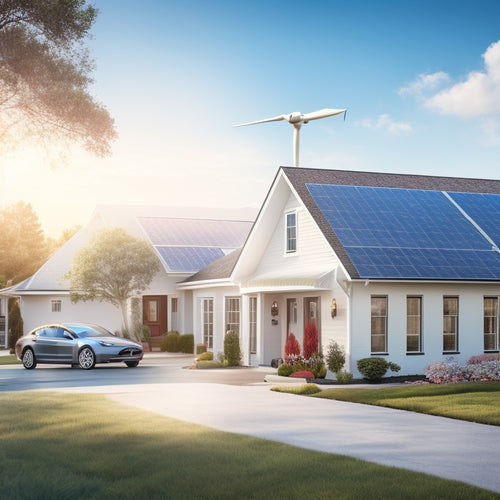Sewing Sustainability: Crafting With Solar-Powered Lighting
Share
You're likely wondering how to make your sewing space more sustainable, and switching to solar-powered lighting is a great place to start. By harnessing renewable energy, you'll reduce your carbon footprint and reliance on finite fossil fuels. Solar-powered lights or LED bulbs consume less energy than traditional incandescent bulbs, and innovative lighting solutions reduce energy consumption, waste, and pollution. As you explore sustainable sewing practices, you'll discover how mindful crafting and eco-friendly materials can make a significant impact. And, as you take the first step towards a greener future, you'll uncover a world of possibilities waiting to be illuminated.
Key Takeaways
• Solar-powered lighting reduces carbon footprint and reliance on non-renewable energy sources in sewing spaces.
• Energy-efficient lighting options, like solar-powered lamps or LED bulbs, lower energy bills and emissions.
• Conducting an energy audit identifies areas of energy waste, allowing for targeted changes to optimize energy usage.
• Strategically placing workstations near windows or skylights maximizes natural light and reduces artificial lighting needs.
• Implementing lighting controls, such as timers or occupancy sensors, optimizes energy consumption in sewing spaces.
Embracing Renewable Energy Sources
By shifting to renewable energy sources, you can substantially reduce your carbon footprint and rely less on finite fossil fuels, ultimately powering your sewing operations with clean energy.
This shift is vital, as the sewing industry is a significant contributor to greenhouse gas emissions.
By embracing renewable energy, you'll not only reduce your environmental impact but also benefit from the financial incentives that come with sustainable practices.
Governments and organizations are implementing renewable policies to encourage the adoption of clean energy.
For instance, tax credits and grants are available for businesses that invest in renewable energy systems.
These green investments can substantially reduce the upfront costs associated with switching to clean energy.
In addition, renewable energy can provide a stable and predictable energy supply, reducing your reliance on volatile fossil fuel markets.
Solar Power for Sewing Spaces
As you consider solar power for your sewing space, you'll want to think about how to maximize your energy efficiency.
One key strategy is to explore energy-efficient lighting options that work in tandem with your solar power system.
Energy-Efficient Lighting Options
When setting up your sewing space, consider swapping traditional lighting for energy-efficient options, like solar-powered lamps or LED bulbs, which can substantially reduce your carbon footprint.
By making this simple switch, you'll not only be doing the environment a favor, but you'll also save on your energy bills.
Conducting an energy audit can help you identify areas where energy is being wasted, allowing you to make targeted changes.
Implementing lighting controls, such as timers or occupancy sensors, can further optimize your energy usage.
Additionally, consider installing smart plugs that can monitor and control the energy consumption of your sewing machines and other devices.
By taking these steps, you'll be well on your way to creating a sustainable sewing space that's not only eco-friendly but also cost-effective.
Optimizing Natural Light
You can maximize natural light in your sewing space by strategically placing your workstation near windows or skylights, reducing the need for artificial lighting and cutting energy costs.
During daylight hours, natural light provides the best illumination for sewing, allowing you to see even the smallest details. By positioning your workstation near a window, you can take advantage of this free and sustainable light source.
When planning your sewing space, consider window placement to optimize natural light.
North-facing windows receive indirect sunlight, making them ideal for sewing spaces. East- and west-facing windows receive direct sunlight during morning and afternoon hours, respectively.
South-facing windows receive direct sunlight throughout the day, but may require shading to prevent overheating.
Energy Efficiency in Crafting
By incorporating energy-efficient practices into your crafting routine, you can substantially reduce your carbon footprint and contribute to a more sustainable future. One vital step is conducting an energy audit to identify areas of improvement in your crafting space. This involves evaluating your energy consumption, identifying energy-wasting habits, and implementing changes to reduce your energy usage.
Another key aspect of energy efficiency in crafting is fabric selection. Choosing sustainable fabrics, such as organic cotton, recycled polyester, or repurposed materials, can notably reduce the environmental impact of your projects.
Energy-efficient tips for crafters:
| Energy-Saving Tips | Benefits |
| Conduct regular energy audits | Identify energy-wasting habits and reduce consumption |
| Choose energy-efficient equipment | Lower energy bills and reduce carbon footprint |
| Opt for sustainable fabrics | Reduce environmental impact of fabric production |
| Implement energy-saving habits | Reduce energy consumption and lower bills |
Sustainable Lighting Options
Two key areas in your crafting space where sustainable lighting can make a substantial impact are your task lighting and ambient lighting.
Task lighting focuses on specific areas where you need concentrated light, such as your sewing machine or worktable.
Ambient lighting, on the other hand, sets the overall mood and atmosphere of your space.
By incorporating sustainable lighting options, you can reduce your carbon footprint and create a more eco-friendly crafting environment.
When it comes to Lighting Innovations, you have several Green Alternatives to choose from.
Consider installing solar-powered lights or LED bulbs, which consume appreciably less energy than traditional incandescent bulbs.
You can also explore energy-harvesting lighting systems that convert natural light into electrical energy.
These innovative solutions not only reduce your energy consumption but also minimize waste and pollution.
Crafting With a Clear Conscience
As you sit down at your sewing machine, surrounded by scraps of fabric and threads, the weight of your environmental impact can be overwhelming, but it's precisely this awareness that sparks a desire to craft with a clear conscience.
You're not alone in this feeling - eco anxiety is a growing concern among crafty individuals.
The good news is that mindful making can be a powerful tool in alleviating this anxiety. By being intentional with your materials, choosing sustainable fabrics, and designing with longevity in mind, you can substantially reduce your environmental footprint.
It's about more than just the end product - it's about the thought and care that goes into every stitch.
As you craft, remember that every decision you make has a ripple effect.
By choosing to craft with a clear conscience, you're not only creating something beautiful, but also contributing to a more sustainable future.
Embrace the power of mindful making, and let your creativity thrive with a clear conscience.
Reducing Carbon Footprint
The production and distribution of sewing supplies, from fabric to threads, can be a significant contributor to greenhouse gas emissions.
As a conscious crafter, you're probably wondering how to reduce your carbon footprint. One effective way is to support suppliers that prioritize sustainability.
Research companies that implement environmentally friendly practices, such as using renewable energy or reducing waste in their supply chain. You can also look for certifications like carbon offsetting, which guarantees that emissions are balanced by investing in renewable energy projects or reforestation.
When shopping for supplies, choose products with minimal packaging or those made from recycled materials. Consider buying second-hand or repurposing old materials to reduce the demand for new, resource-intensive supplies.
Solar Panels for Sewing Rooms
Harnessing the power of solar energy, you can substantially reduce your sewing room's reliance on non-renewable energy sources and lower your carbon footprint. By installing solar panels, you'll be generating clean energy and reducing your dependence on the grid. This not only benefits the environment but also saves you money on your energy bills.
To guarantee peak energy production, regular Panel Maintenance is crucial. This includes cleaning the panels to remove dirt and debris, inspecting for damage, and replacing components as needed. Proper maintenance will certify your solar panels operate at maximum efficiency.
To monitor your energy production and consumption, consider investing in an Energy Monitoring system. This will provide you with real-time data on your energy usage, helping you identify areas for improvement and fine-tune your solar panel performance. By combining solar panels with energy monitoring, you'll be well on your way to a sustainable sewing room that's not only eco-friendly but also cost-effective.
Eco-Friendly Sewing Essentials
Stock up on eco-friendly sewing essentials, like recycled threads, organic fabrics, and repurposed materials, to minimize waste and reduce your sewing room's environmental impact.
By incorporating eco-friendly sewing essentials into your crafting routine, you'll not only reduce your carbon footprint but also create unique, sustainable pieces that showcase your commitment to the environment.
Organic fabrics: Swap conventional fabrics for organic cotton, hemp, or bamboo fabrics that are grown without toxic pesticides and synthetic fertilizers.
Repurposed materials: Get creative with repurposed materials like old clothing, fabric scraps, and vintage textiles to reduce waste and create one-of-a-kind pieces.
Eco-friendly threads: Opt for threads made from recycled materials, natural fibers, or plant-based dyes to minimize chemical usage.
Bright Ideas for Sustainable Sewing
As you venture into sustainable sewing, explore innovative techniques that not only reduce waste but also add an extra layer of creativity to your projects. One area to focus on is minimizing fabric waste. Consider using scraps to create unique embellishments or incorporating them into your design. You can also repurpose old fabrics, giving them new life in your creations.
Another bright idea is thread recycling. Instead of throwing away leftover threads, collect and reuse them in your projects. This not only reduces waste but also adds a touch of sustainability to your sewing.
Here are some eco-friendly sewing ideas to get you started:
| Technique | Benefits | Tips |
|---|---|---|
| Zero-waste design | Reduces fabric waste | Plan your design carefully to maximize fabric usage |
| Thread recycling | Reduces thread waste | Sort threads by color and type for easy reuse |
| Fabric scraps reuse | Reduces fabric waste | Get creative with scrap fabric uses, like embellishments or quilting |
Illuminating a Greener Future
By adopting sustainable sewing practices, you're not only reducing waste but also contributing to a greener future, one stitch at a time.
As an Eco Warrior, you're part of a movement that's driving Green Innovations in the sewing industry. By embracing solar-powered lighting, you're reducing your carbon footprint and paving the way for a more sustainable future.
Solar-powered lighting can illuminate a greener future in several ways:
-
Reduced energy consumption: Solar-powered lighting harnesses the power of the sun, reducing your reliance on traditional energy sources and minimizing your impact on the environment.
-
Increased productivity: With a reliable and consistent light source, you can sew for longer periods without interruptions, increasing your productivity and creativity.
-
Cost-effective: Solar-powered lighting can substantially reduce your energy costs, allowing you to invest in more sustainable materials and practices.
Frequently Asked Questions
Can I Use Solar-Powered Lighting for Nighttime Sewing Sessions?
"You can totally use solar-powered lighting for nighttime sewing sessions, enjoying energy efficiency while experiencing creative freedom, as the soft, eco-friendly glow illuminates your stitches, fostering an innovative sewing experience."
Are Solar Panels Compatible With All Sewing Machine Types?
You'll be glad to know that most solar panels are compatible with various sewing machine types, considering energy efficiency and power output. However, it's vital to check your machine's voltage and wattage requirements to guarantee a seamless match.
Can I Install Solar Panels on a Rented Sewing Space?
Before installing solar panels in your rented sewing space, you'll need to review your rental contract and obtain permission from your landlord, as modifications may require prior approval through a formal agreement.
Do Solar-Powered Lights Affect Fabric Color Accuracy?
When you sew, you know that color accuracy matters. Solar-powered lights can affect fabric color perception, especially if the light intensity is low. Be aware that this might impact your project's overall aesthetic.
Are Solar-Powered Sewing Machines Available on the Market?
You're looking for solar-powered sewing machines, and yes, they're available on the market, offering energy efficiency and eco-friendly alternatives to traditional machines, making your stitching more sustainable and environmentally friendly.
Related Posts
-

Why You Need a Phone Mount for Navigation
When you're on the road, a reliable phone mount is not just a convenience, it's a safety necessity that helps you mai...
-

What You Need to Know About RV Solar Maintenance
When you're out on the road, your RV's solar panel system is your lifeline. But without regular maintenance, you're l...
-

Why Homeowners Are Embracing DIY Energy Independence
By taking control of your energy needs, you're breaking free from the uncertainty of utility bills and embracing a se...


